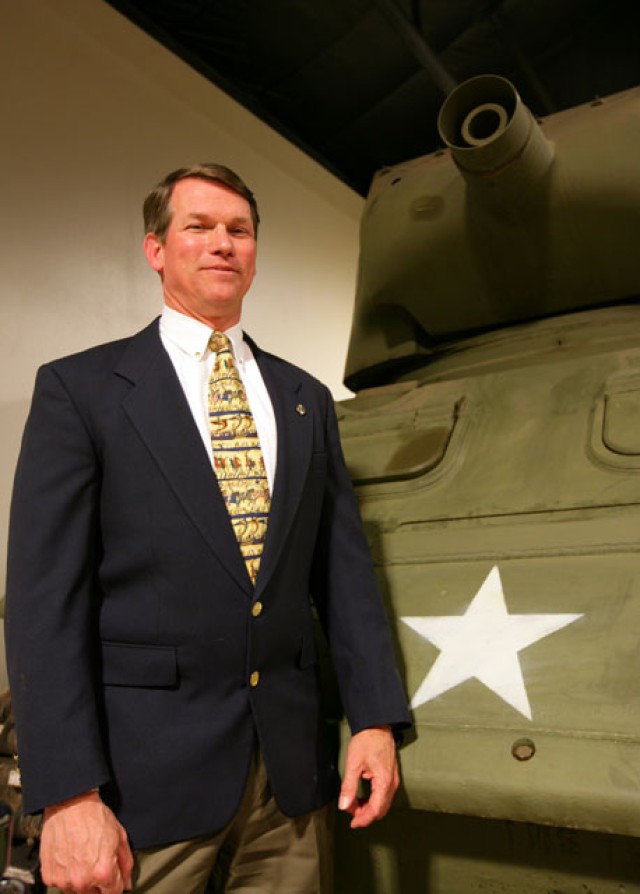Starting up a museum is nothing new for U.S. Army Field Artillery Museum Director and Curator Gordon Blaker.
He put together the first collection for the Berman Museum of World History and was its first director. As director of curatorial services at the Augusta (Ga.) Museum of History, he completely replaced the main exhibition.
Blaker brings his diverse museum experience as well as a career as an Army officer to his position at the new Field Artillery Museum at Fort Sill.
"I want to build the finest artillery museum in the country," said Blaker, who was most recently the curator of collections at the National Museum of the Army Reserve at Fort McPherson, Ga. "I want it to have outstanding examples of field artillery, uniforms, insignias and flags. We've got some fantastic artifacts."
With an interest in history and the military, Blaker was able to combine the two in his post secondary school studies.
After graduating from Carmel (Ind.) High School in 1974, Blaker attended Indiana University. He majored in history and participated in ROTC.
"I've always been interested in the material culture (artifacts) aspects more than just straight historical aspects," he said. "I've always had a strong military slant."
Blaker said he graduated from IU in May 1978, with enough credits to complete the history degree twice over and with a concentration in American and European history.
Also upon graduation, Blaker received his Army commission. His first assignment was with the 1st Battalion, 33rd Armored Regiment in Gelnhausen, Germany.
During a subsequent Army assignment at the Joint Warfare Center at Hurlburt Field, Fla., Blaker took evening classes to earn a master's degree in American history from the University of West Flordia.
"It was in Pensacola, 50 miles away, so it was a bit of driving," he said.
With the Army downsizing in 1995, Blaker retired as a major with more than 17 years of service. After retirement Blaker considered either going into business or getting into museum or historical work.
In 1995, he was offered the director job at the Berman Museum, a private facility in Anniston, Ala. The museum showcased the weapons collection of Farley Berman, and his wife, Germaine's art collection.
"It was a small staff. We had three people and we basically built the first exhibits and everything there in the museum," Blaker said. "It was a lot of fun."
With such a small staff, Blaker had to do a bit of everything including working with artifacts, training the museum tour guides or docents, giving classes and performing outreach presentations.
Blaker lived in Anniston, while his wife, Karen, a librarian, worked and lived in Augusta, four hours away and where their home was. Because it was impractical for him to make a daily commute, Blaker kept a place in Anniston.
"I worked very long days Mondays through Thursdays and would go home on Fridays," he said.
After almost two years at Berman, Blaker left to become the director of curatorial services at the Augusta museum in 1997. As chief curator, Blaker performed research on the museum's artifacts, researching them and writing their labels.
The museum was about 70,000 square-feet, Blaker said.
"It was big enough where we had a steam locomotive, coal tender and passenger car inside the building," he said.
After leaving the Augusta museum after about nine years, Blaker went to the Army Reserve museum, which told the history of the Citizen-Soldier, beginning with the French and Indian Wars.
"It was pretty small and it was a museum in the headquarters building," he said. "Our exhibit cases were scattered out over five floors."
Blaker arrived at Fort Sill in December. He and a small group of people have been busy preparing the 38,000 square-foot Field Artillery Museum for its opening in early June.
What has to be done between now and then'
"Absolutely everything," said Blaker, who will eventually hire two museum specialists.
For now, Blaker, three museum specialists on loan from the Fort Sill Museum and three volunteers are performing research, gathering artifacts and cleaning them, painting walls, setting up exhibits and displays and much more.
"I am just interested in getting a great museum started here," he said.
Blaker is also looking for volunteers. Anyone who is interested in volunteering at the Army Field Artillery Museum can call him at 303-854-7598.


Social Sharing